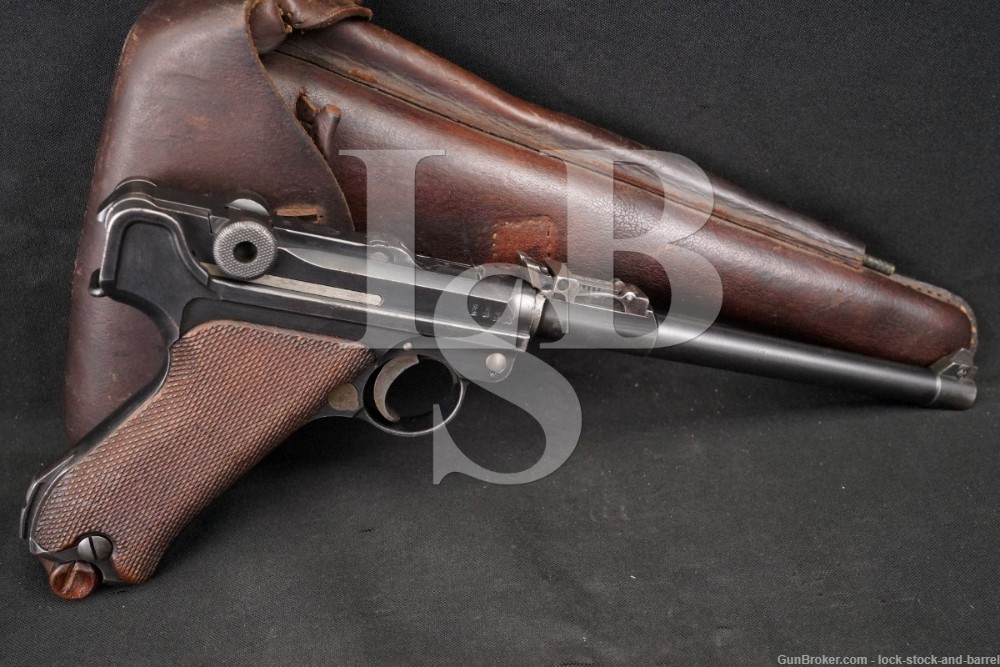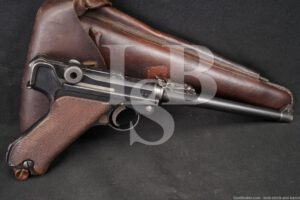
WWI DWM Lange Pistole Artillery Luger 9mm 7.9″ Semi-Auto Pistol 1917 C&R
SOLD FOR: $3500
LSB#: 220906PG254
Make: Deutsche Waffen-und Munitionsfabriken (DWM)
Model: Lange Pistole 08, “Artillery Luger”
Serial#: 3348c
Year of Manufacture: 1917, C&R
Caliber: 9mm Luger
Action Type: Semi-Automatic Pistol fed by a Detachable Magazine
Markings: The bottom of the barrel is marked “3348 / c” which is the serial number and “8,82”. The bottom of the chamber ring has some stamps. The left side of the slide is marked “3348”. The trigger bar is marked “48”. The top of the chamber ring is marked “1917”. The right side of the slide is marked with three Gothic German letters under crowns and a DWM army test proof (an eagle). The right side of the barrel has an army test proof but the one used at Erfurt Arsenal (also an eagle but it has a different appearance), this is a commonly encountered anomaly on DWM Lugers made near the end of WWI. The firing pin is marked “48”. The left side of the breech-block is marked “48” and has the DWM army test proof. The extractor is marked “48”. The forward toggle is marked with the “DWM” logo and “48”. The rear toggle is marked “48”. The hold-open latch is marked “48”. The locking bolt is marked “48”. The trigger side-plate is marked “48”. The trigger is marked “48”. The front of the frame is marked “3348 / c”. The rear sight’s base is marked “48”, the slider is marked “48” and the V-notch is marked “48”. The safety bar is marked “48”.
Barrel Length: Approximately 7.9” (200mm)
Sights/ Optics: The front sight is a serrated blade dovetailed to a serrated base. The rear sight is an adjustable tangent leaf “V”-notch. The rear sight is marked 1-8, inclusive.
Stock Configuration & Condition/ Grip: The grips are two-piece checkered wood. The grips have some light handling marks, nicks and scuffs. Notably, there is a light crack on the left panel under the safety notch and some patches of discoloration. The checkering is mostly sharp. Overall, the grips are in Very Good condition.
Type of Finish: Blue and Straw
Finish Originality: Original
Bore Condition: The bore is semi-bright with sharp rifling. There is some light erosion concentrated in the grooves.
Overall Condition: The pistol retains about 75% of its metal finish. There are some light handling marks, nicks and scuffs on the gun’s metal surfaces. Notably, the finish has worn off around the muzzle and leading edges. Also, there are scattered patches of light surface oxidation where the finish has thinned/worn off and some patches of light pitting on the left side of the barrel. The markings remain clear. The screwheads are only lightly tooled and remain serviceable. Overall, the pistol is in Very Good condition.
Mechanics: The action functions correctly. The slide to frame fit is snug. We have not fired this pistol. As with all used firearms, a thorough cleaning may be necessary to meet your maintenance requirements.
Box Paperwork and Accessories: The gun comes with an appropriate brown leather holster meant for the Lange Pistole 08 (there is no indication the holster was made for this exact pistol though, and it lacks any surviving maker’s marking) and a cleaning rod. The holster has some light-moderate handling marks with the strap that secures the lid having fallen off. Overall, the holster is in Good condition. Also included is a single magazine with a wood base marked “3327 / a”. The magazine is not matching. The magazine has some light wear and is coated in light oxidation, but it remains in Very Good condition.
Our Assessment: The Parabellum-Pistole 1908, commonly referred to as the Luger, was designed by Georg Johann Luger. Luger was an unlikely gun designer, born in 1849 he was the son of a surgeon, Bartholomaeus von Luger, and while attending university he served as a One-Year Volunteer with the 78th Infantry Regiment (Infanterieregiment 78 ein) of the Austro-Hungarian Army. While in the military Luger proved himself a skilled marksman and he began to develop an interest in the small arms technology. Following four years of service Luger worked a number of jobs in Vienna. Finally, in the 1870s Luger met Ferdinand Ritter von Mannlicher who recruited him as a sales representative for Deutsche Waffen und Munitionsfabrik AG (DWM). One of the company’s weapons that Luger marketed was the Borchardt C93 (named after its designer Hugo Borchardt) which was criticized for being too heavy and poorly balanced. Luger decided to rework the design and eventually secured a contract for his new pistol with the Swiss Army which dubbed it the model 1900 which was chambered for 7.65mm Parabellum cartridges. After some minor reworking Luger introduced the Pistole 1904, chambered for 9mm cartridges, which was adopted by the Imperial German Navy, the pistol was henceforth referred to as the Luger. A slightly altered version of the pistol with a smaller barrel was adopted for service by the Prussian Army in 1908, hence the designation P08. The P08 would become one of the most iconic weapons of the 20th century. Following the end of WWI Luger was bankrupted, he had invested in War Bonds which had become worthless following Imperial Germany’s defeat and worse yet he was forced out of his job by his employer DWM which sought to appropriate his patents. The ensuing legal dispute between Luger and DWM would be decided in his favor in 1922, but he was financially ruined by that time and passed away the following year at the age of 74. His pistol would continue to serve the German military during WWII (although the P38 was the Wehrmacht’s standard issue sidearm) and saw service in a number military and police forces after the war.
In 1913 Kaiser Wilhelm II, the German Emperor, allowed for the adoption of the Lange Pistole 08 colloquially known as the “Artillery Luger”. The gun featured a longer barrel, 8-position tangent rear sight and a provision for a shoulder stock (no shoulder stock is included with this gun). Although originally intended as a defensive armament for artillery and machine gun crews, the Lange Pistole was used throughout the German military, including as a carbine with a drum magazine (no drum magazine is included with the gun) by the famous Stoßtruppen (storm troopers) during WWI. Some surplus Lange Pistoles survived WWI and were eventually pressed into service during WWII, but not to the same extent as the gun had been used in the First World War.
This particular specimen is a beautiful handgun. It has all matching parts except the magazine, including the distinct rear sight and extended barrel. One thing worth noting, there is an Erfurt style German Army inspection mark on the barrel despite the gun being made by DWM. This was a common feature of late war guns, while there is no surviving record to explain this anomaly it is widely accepted that this was done during WWI. Aside from the magazine and holster, all the guns parts are serial matched. The gun retains the ergonomic fit, pleasing aesthetic and mechanical prowess one would expect from a Luger. This is a great option for historical firearms collectors. Good luck on your bid!

